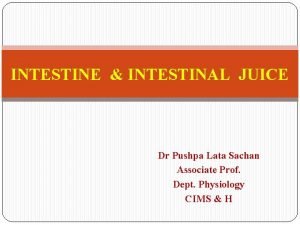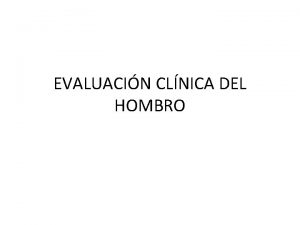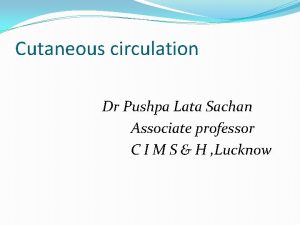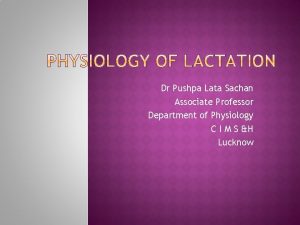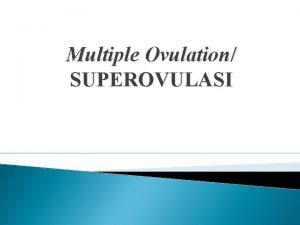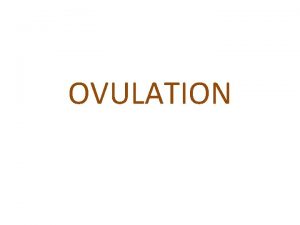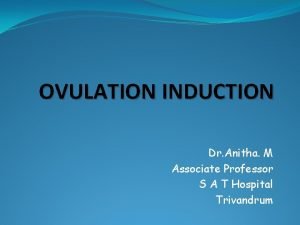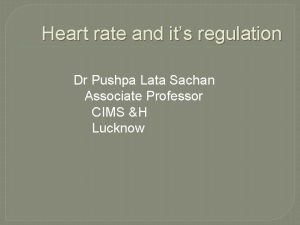OVULATION TEST Dr Pushpa Lata Sachan Associate Professor










- Slides: 10

OVULATION TEST Dr Pushpa Lata Sachan Associate Professor Department of Physiology C I M S &H Lucknow

OVULATION TEST Ovulation -Is the process of ovum from ovary that result from rupture of graffian follicle at the end of follicular phase of the menstrual cycle. It is important to know the day of ovulation for its physiological and clinical significance. Indicators of ovulation are as follows.

Indicators of ovulation � 1 - Rise in of basal body temperature – Increases during ovulation by about 0. 5 c . �Accurate charting of this temperature can exactly detect the day of ovulation. �(a) It is recorded orally , early in the morning before getting up of bed , and before taking any drink or washing the mouth.

�(b) –The increase in body temperature is due to the influence of progesterone that starts increasing with the beginning of secretory phase. �Progesterone is thermogenic. �(2) Fleeting lower abdominal pain -With ovulation , bleeding occur into antrum of follicle.

�(a) Small amount of blood escapes into abdominal cavity which causes peritonial irritation and abdominal pain. �This is called as (Mittelschmerz). �(3) Vaginal discharge – (Spotting ) Transitory increase in vaginal discharge during ovulation. �(a) When rise in BBT is associated with mittelschmerz and spotting –collectively called as ovulation cascade.

�(b) –If all the three features are present occurrence of ovulation almost confirmed. 4 –Spinnbarkeit –in proliferative phase , estrogen makes the cervical mucous thin and alkaline. (a) With the beginning of secretory phase , progesterone secreted from corpus luteum makes the mucous thick and tenacious. (b) Thus , uterine mucous is thinnest at the time of ovulation and its elasticity is maximal.

�(b) Spinnbarkeit - Cervical mucus at the time of ovulation can be stretched as long as 10 cm or more like a thread. This elastic nature of mucous is called as spinnbarkeit. �(c) Decreased elasticity indicate ovulation has taken place.

Fern test � 5 –Fern test –under the effect of estrogen , cervical mucus before ovulation forms an arborizing fern like pattern, when the mucus is spread on slide. �(a) This is confirmed by microscopic examination of the mucous smear. �(b) Following ovulation , due to progesterone effect , the mucous become thick and fern pattern is not observed in smear of mucous.

� 6 - Laparoscopic observation –Demonstrating ovum in abdominal cavity by laparoscopy confirm ovulation. � 7 –Demonstration of LH Peak – LH surge occurs just prior to ovulation. �Daily estimation of plasma LH in the periovulatory period will accurately detect the day of ovulation.

 Promotion from assistant to associate professor
Promotion from assistant to associate professor Sachan thapa
Sachan thapa Test speed hombro
Test speed hombro Ovulation negative feedback
Ovulation negative feedback Puberty reproductive system
Puberty reproductive system Hidden ovulation
Hidden ovulation An egg's journey from ovulation to menstruation storyboard
An egg's journey from ovulation to menstruation storyboard Billings method
Billings method Lesson 15.4 ovulation fertilization and implantation
Lesson 15.4 ovulation fertilization and implantation Ovulation
Ovulation Chapter 36 section 1 reproductive systems
Chapter 36 section 1 reproductive systems

